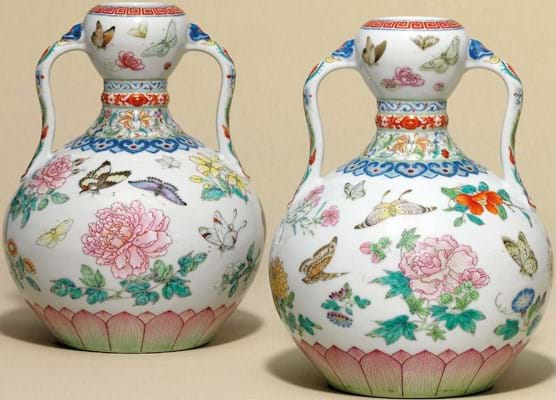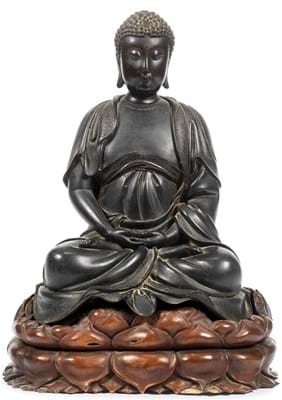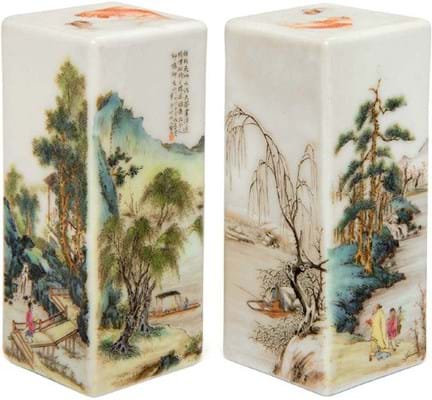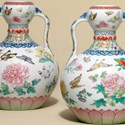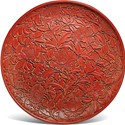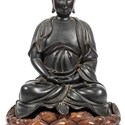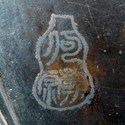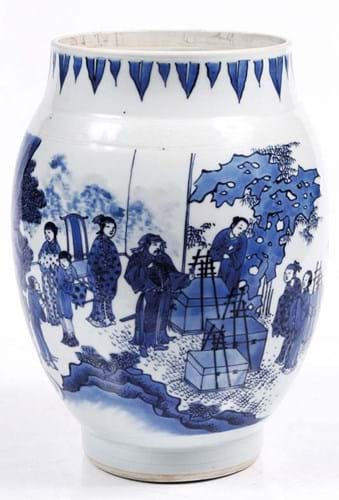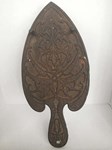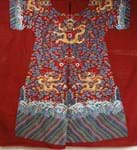Crowning the recent Asian art sales – and bringing more than a third of the total take across the £33m series – was a splendid pair of Qianlong (1736-95) mark and period famille rose ‘butterfly’ double-gourd vases.
Collected in the 1930s in London by an English lady from a noble family, the current owner had “no idea of their true value”. Hong Kong would typically be the destination for an item of this calibre. It was a boon for London that they sold here – and sold so well.
The pair, estimated at £2m-3m, prompted 15 minutes of bidding across 10 potential suitors before they were hammered down at £13m. Discounting the so-called Bainbridge’s vase, £13m is the second-highest price for Chinese art in the UK next to the £14m Yuan dynasty guan sold at Christie’s King Street in 2005.
Double appeal
Representing the last great political and artistic flowering before the terminal decline of the later Qing emperors, imperial wares from the reign of Yongzheng and his fourth son and successor, Qianlong, continue to set the benchmark in the Asian art market. They appeal on aesthetic and emotional levels.
These 9in (23cm) high vases, that perhaps once resided in the Yuanmingyuan or similar courtly dwelling, are decorated with great delicacy in falangcai enamels on an incised ‘graviata’ ground. As a pair they are complementary rather than identical. And the wealth of auspicious messages spoken by the language of flowers would have rendered them suitable for presentation on the occasion of an important birthday or similarly significant celebration. In Chinese the word for butterflies is homophone for ‘repeat’, suggesting in this case the duplication of any wish.
Only four other vases of this type are recorded (all singles), including that sold first by Christie’s in 2003 and again in 2007 for HK$13.76m.
Many similarities exist too with the famous pink-ground butterfly vase, formerly part of the Fonthill Heirlooms and latterly the JT Tai collection, which was sold by Christie’s Hong Kong in December 2008 for HK$53.3m.
There is no doubt that the potential rewards in the Chinese market remain spectacular. With this kind of finance in play, Asian week continued to buzz. Potential buyers, fired with the collecting gene some fear is disappearing in the West, can be counted in the thousands.
The market also continues to evolve subtly.
Relative to the Ming and Qing porcelain, jades and bronzes that remain so strong, the greatest pieces of Chinese lacquer have been underpriced.
A little of that imbalance was redressed when a 17½in (45cm) carved cinnabar lacquer dish from the late Yuan or early Ming period sold to an Asian private buyer at Sotheby’s on May 10 for £1.3m. Made in the era when lacquer carving reached its zenith, the design interweaves a dozen naturalistically rendered plants and carries the needle-engraved signature Zhang Cheng zao.
This is a reference to a celebrated lacquer craftsman from Xitang in Zhejiang province recorded in the Gegu yaolun (The Essential Criteria of Antiquities) of 1388. When last sold at Sotheby’s in 1972, the dish took £1600.
Thangka white gloves
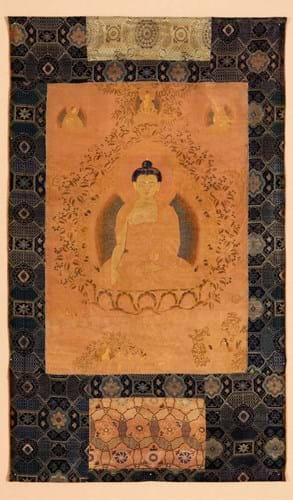
A rare 18th century distemper and gold on silk thangka of Ratnagni Buddha that sold for £255,000 (estimate £20,000-30,000) as part of the Jongen-Schleiper collection at Bonhams on May 11. This thangka, once part of a set devoted to the previous lives of Shakyamuni Buddha, included an extensive inscription on the reverse detailing the donor. The collection was formed by Jeanette Jongen and Eric Schleiper following a first visit to Tibet in the early 1970s.
The sale of 49 thangkas from the Jongen-Schleiper collection at Bonhams on May 11 proved the easiest of the week – a ‘white-glove’ event for what were primarily late works from the 18th and 19th centuries.
Specialist Asaph Hyman believed the sale “set a new international standard for later Tibetan thangka paintings”.
A triptych of distemper on cloth thangkas depicting the lineage of the Panchen Lamas of Tashilhunpo dating from c.1835 topped proceedings at a mighty £455,000.
Twenty years ago, when collectors were turning their noses up at anything from the late Qing period, it was possible to buy a top-flight piece of Republican (1912-49) porcelain for a few hundred pounds.
However, the market for the work of ‘Eight Friends of Zhushan’ group of artists in particular has escalated over the past decade.
Kate Hunt, specialist at Christie’s South Kensington, described a pair of 3½in (9cm) famille rose ‘landscape’ seals decorated and signed by He Xuren (1882-1940) as “examples of the finest painting in the Republic period”. The owner had acquired them relatively recently in the UK.
According to the inscription, the seals were made as a gift for Zhu Peide (1888-1937), a senior commander in the Nationalist Party and the governor of Jiangxi province where the Eight Friends would meet to discuss their trade on moonlit nights. The saleroom’s good track record in this area continued when the pair sold at £180,000 (estimate £30,000-50,000).
Traditionally a Western collecting category, the painterly blue and white Transitional porcelains made in the years between the Ming and Qing dynasties, when the loss of court patronage allowed for greater artistic freedom, are gaining popularity with Chinese collectors.
Many carry scenes inspired by traditional folklore and woodcut illustrations that were available for artists to copy by this period.
From a private Edinburgh collection, a typical 10in (25cm) ovoid jar with decoration taken from the Romance of the Three Kingdoms sold for £34,000 at Lyon & Turnbull in May, while a similar 11in (27cm) vase c.1630-50 sold to an internet bidder for £36,000 at Mallams in Cheltenham on April 26. Inherited by the vendor from his father, it had been spotted by auctioneer Robin Fisher when invited to value an oak dresser.
Serendipity and expertise
Britain’s long commercial ties and military history ensures that, with equal doses of serendipity and expertise, good things will continue to turn up in this way.
However, after a decade or more of sell, sell, sell and a modern Silk Road that now moves only from west to east, the dwindling supply of good-quality, well-provenanced material has become the primary issue facing the UK market.
Certainly, many catalogues were self-consciously trimmed to reflect growing selectivity and the increasing need to err on the side of caution wherever debatable items are brought for valuation.
However, the raw sale statistics do tell a story of sorts. With the possible exception of Bonhams – the one saleroom to offer a large-scale selection (including two sales of Japanese art) – lot numbers and totals were generally down.
It is apt to conclude that the crazy days of the noughties, when these sales collectively numbered thousands of lots and revenues towered into the tens of millions, are behind us.
Perhaps that is why, shortly after the sale of those £13m vases, it emerged Jeremy Morgan would be leaving Christie’s alongside former King Street head Pedram Rasti as part of restructuring plans.
CSK’s sale – the last before the July closure of the saleroom and the movement of the department to King Street – was a one-day event with just over 300 lots. Likewise, by the firm’s own very high standards, the £1.2m sale at Woolley & Wallis was a relatively modest affair with two catalogues numbering 99 and 337 lots.
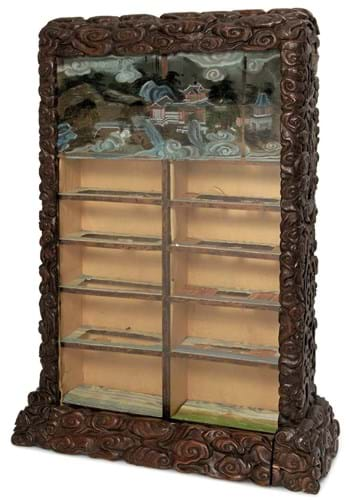
This ingenious 19th century device, described by Christie’s South Kensington as a ‘curiosity mirror’, was estimated at £15,000-25,000 but sold at £220,000. Through two peep holes in the aloeswood frame the viewer can admire scenes of figures in a European street or figures in boats on a lake. Mirrors and columns of painted shelves create a sense of perspective. A similar mirror offered at Christie’s in May 2007 sold at just £24,000.
The regional picture
In truth, many of the regional rooms found sourcing tougher than ever this time around. Duke’s two late 20th century scroll paintings by Wu Guanzhong (1919-2010), spotted by director Guy Schwinge during “a routine valuation” and sold at £500,000 and £300,000 (see ATG No 2293), were comfortably the top prices of the month, with L&T providing the only other six-figure lot in an otherwise difficult sale.
Few auctioneers care to admit it but a rising percentage of material sold in the UK now comes from sources across the Far East, where vendors are keen to benefit from the lustre of a British provenance. Some are bona fide objects. Other ‘gift horses’ should be greeted with more suspicion.
Many of the current crop of fakes are extremely good, exhibiting only small differences in gilding, carving, enamelling, potting and paste than from original works of art.
Some of them come with ‘old’ collection labels. Some have been deliberately smashed and repaired to suggest a long history. Others are consigned with sepia photographs photo-shopped to show objects apparently ‘in situ’ decades ago.
Privately, members of the trade expressed the feeling that the volume of modern fakes at one or two sales was unacceptable. That some will occasionally sell for substantial prices is only storing up problems for the future.
It is the strength of the UK market that buyers come here in the expectation of finding honest items from old collections.
It would be unfortunate if the market, as it comes under pressure to perform as before, was instead to shoot itself in the foot.
London Asian art sales at a glance
Bonhams Bond Street: Fine Chinese Art May 11
■ 259 lots offered
■ 159 lots (61%) sold
Sale total: £3.9m
Bonhams Bond Street: The Jongen-Schleiper Collection of Thangkas May 9
■ 49 lots offered
■ 49 lots (100%) sold
£1.78m
Bonhams Bond Street: Fine Japanese Art May 11
■ 425 lots offered
■ 301 lots (71%) sold
£1.12m
Bonhams Bond Street: Katchen Collection of Netsuke Part II May 10
■ 199 lots offered
■ 175 lots (88%) sold
£943,450
Bonhams Knightbridge: Asian Art May 8
■ 687 lots offered
■ 426 lots (62%) sold
£1.2m
Christie’s: Important Chinese Art May 9
■ 137 lots offered
■ 81 lots (59%) sold
£16.9m
Christie’s South Kensington: Chinese Art May 12
■ 321 lots offered
■ 259 lots (81%) sold
£1.84m
Sotheby’s: Important Chinese Art May 10
■ 198 lots offered
■ 144 lots (74%) sold
£4.4m
Sotheby’s: Menagerie, an English Collection May 10
■ 100 lots offered
■ 82 lots (82%) sold


